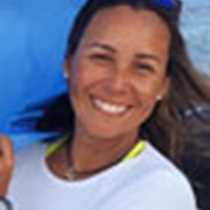Isabela Island
One of the best feelings during our expedition on board the National Geographic Islander in the Galápagos Islands is to wake up every morning to a new landscape. This morning, the sun rose over the profile of a magnificent caldera, Alcedo volcano, located in the heart of Isabela Island. Here is found Urvina Bay, our visit this morning, a bizarre place due to its recent geological history.
Urvina is a portion of coastline that was uplifted in a short span of time in 1954. The proof of how suddenly this event happened (perhaps just a very few days!) was the number of dead marine animals washed ashore as well as the huge coral heads found by witnesses at the time. Fifty five years later, we can still find much of this evidence all along this trail. It crosses through an area of dry vegetation, which after the rainy season looked still pretty green.
Our walkers this morning were accompanied by dozens of Darwin finches, yellow warblers and Galápagos mockingbirds. A not-so-commonly-seen dark billed cuckoo was spotted twice, and in the distance an adult Galápagos hawk observed his territory from the canopy of a tree. The air and ground got warmer as the day went by, so some land iguanas started making their way to the open areas, in order to bask in the sun. After the walk, many guests decided to cool off too in the sea, enjoying the beautiful beach of Urvina Bay.
In the afternoon, more exploration was to come, this time further south, towards the coast formed by lavas of the adjacent volcano: Cerro Azul. This active volcano, which went through a mild volcanic process as recently as last year, has created vast lava fields like the ones of Punta Moreno, which we set off to explore. Here, we found impressive solidified textures and prints left by a massive lava flow along a barren trail, but we also found a few oasis of life, in the form of brackish little lagoons scattered in the lava field. These are the perfect habitat for a very attractive species, the greater flamingo, of which we observed a few, as well as some common gallinules.
After the Zodiacs came to pick up everyone ashore, we enjoyed some extra time exploring the coastline of Punta Moreno, with its hidden coves and mangrove areas. To our guests’s amazement, here we found species we had not encountered until now: golden cownosed rays and spotted eagle rays. And wow, they were there in large numbers! These quiet waters also shelter many Pacific green sea turtles, a safe haven for them, having no predators around. We also had one last sighting of the flightless cormorants, which inhabit Isabela and Fernandina islands only, before we returned back on board to prepare for another long navigation in order to reach our destination for tomorrow: Floreana Island.
One of the best feelings during our expedition on board the National Geographic Islander in the Galápagos Islands is to wake up every morning to a new landscape. This morning, the sun rose over the profile of a magnificent caldera, Alcedo volcano, located in the heart of Isabela Island. Here is found Urvina Bay, our visit this morning, a bizarre place due to its recent geological history.
Urvina is a portion of coastline that was uplifted in a short span of time in 1954. The proof of how suddenly this event happened (perhaps just a very few days!) was the number of dead marine animals washed ashore as well as the huge coral heads found by witnesses at the time. Fifty five years later, we can still find much of this evidence all along this trail. It crosses through an area of dry vegetation, which after the rainy season looked still pretty green.
Our walkers this morning were accompanied by dozens of Darwin finches, yellow warblers and Galápagos mockingbirds. A not-so-commonly-seen dark billed cuckoo was spotted twice, and in the distance an adult Galápagos hawk observed his territory from the canopy of a tree. The air and ground got warmer as the day went by, so some land iguanas started making their way to the open areas, in order to bask in the sun. After the walk, many guests decided to cool off too in the sea, enjoying the beautiful beach of Urvina Bay.
In the afternoon, more exploration was to come, this time further south, towards the coast formed by lavas of the adjacent volcano: Cerro Azul. This active volcano, which went through a mild volcanic process as recently as last year, has created vast lava fields like the ones of Punta Moreno, which we set off to explore. Here, we found impressive solidified textures and prints left by a massive lava flow along a barren trail, but we also found a few oasis of life, in the form of brackish little lagoons scattered in the lava field. These are the perfect habitat for a very attractive species, the greater flamingo, of which we observed a few, as well as some common gallinules.
After the Zodiacs came to pick up everyone ashore, we enjoyed some extra time exploring the coastline of Punta Moreno, with its hidden coves and mangrove areas. To our guests’s amazement, here we found species we had not encountered until now: golden cownosed rays and spotted eagle rays. And wow, they were there in large numbers! These quiet waters also shelter many Pacific green sea turtles, a safe haven for them, having no predators around. We also had one last sighting of the flightless cormorants, which inhabit Isabela and Fernandina islands only, before we returned back on board to prepare for another long navigation in order to reach our destination for tomorrow: Floreana Island.




